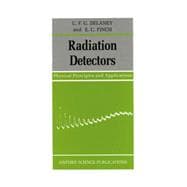
Note: Supplemental materials are not guaranteed with Rental or Used book purchases.
Purchase Benefits
What is included with this book?
| Introduction | p. 1 |
| Aims and objectives | p. 1 |
| Early history of detectors | p. 1 |
| Atoms and nuclei | p. 3 |
| General features of radioactivity | p. 8 |
| Types of nuclear decay | p. 16 |
| Accelerated charged particles | p. 31 |
| X-rays | p. 33 |
| Neutrons and other radiations from nuclear reactions | p. 36 |
| References | p. 40 |
| Further reading | p. 40 |
| Interactions of radiations with matter | p. 41 |
| Introduction | p. 41 |
| Interaction of directly ionizing particles | p. 41 |
| Gamma-ray interactions with matter | p. 52 |
| Neutron interactions | p. 62 |
| Implications for detection methods | p. 64 |
| Reference | p. 65 |
| Gas-filled detectors | p. 66 |
| Introduction | p. 66 |
| Ionization chambers | p. 66 |
| Proportional counters | p. 83 |
| Geiger counters | p. 97 |
| References | p. 107 |
| Further reading | p. 107 |
| Scintillation counters | p. 108 |
| Introduction | p. 108 |
| Inorganic scintillators | p. 111 |
| Organic scintillators | p. 116 |
| Photomultipliers | p. 119 |
| Applications of scintillation counting | p. 145 |
| References | p. 153 |
| Further reading | p. 153 |
| Semiconductor detectors | p. 154 |
| Introduction | p. 154 |
| Band structure of semiconductors | p. 155 |
| Current flow in bulk semiconductors | p. 160 |
| Junction detectors: principles | p. 164 |
| Silicon junction detectors: practice | p. 172 |
| Lithium-drifted detectors: principles | p. 189 |
| Si(Li) detectors | p. 193 |
| Ge(Li) detectors | p. 197 |
| HPGe detectors | p. 203 |
| Semiconductor detectors for neutrons | p. 206 |
| Radiation damage in semiconductor detectors | p. 210 |
| Detectors made from special materials | p. 211 |
| References | p. 213 |
| Further reading | p. 213 |
| Electronics for radiation detection | p. 214 |
| Introduction | p. 214 |
| Amplification principles for radiation detectors | p. 215 |
| Preamplifiers | p. 218 |
| Main amplifiers | p. 237 |
| Simple counting and analysis systems | p. 249 |
| Multichannel analysers | p. 254 |
| Timing systems | p. 262 |
| Coincidence units | p. 277 |
| Housing of electronic units | p. 280 |
| A complete system | p. 282 |
| References | p. 282 |
| Further reading | p. 282 |
| Energy resolution in radiation detectors | p. 283 |
| The necessity for good energy resolution | p. 283 |
| Sources of instrumental linewidth | p. 283 |
| Noise in signal | p. 284 |
| Electronic noise and linewidth | p. 299 |
| Appendix: Noise calculations for the charge-sensitive preamplifier | p. 324 |
| References | p. 325 |
| Further reading | p. 326 |
| Miscellaneous detectors | p. 327 |
| Introduction | p. 327 |
| Cherenkov detectors | p. 327 |
| Special detectors using noble gases | p. 331 |
| Detectors with event storage properties | p. 333 |
| Calorimetric detectors | p. 340 |
| References | p. 348 |
| Further reading | p. 349 |
| General bibliography | p. 350 |
| Index | p. 351 |
| Table of Contents provided by Blackwell. All Rights Reserved. |
The New copy of this book will include any supplemental materials advertised. Please check the title of the book to determine if it should include any access cards, study guides, lab manuals, CDs, etc.
The Used, Rental and eBook copies of this book are not guaranteed to include any supplemental materials. Typically, only the book itself is included. This is true even if the title states it includes any access cards, study guides, lab manuals, CDs, etc.